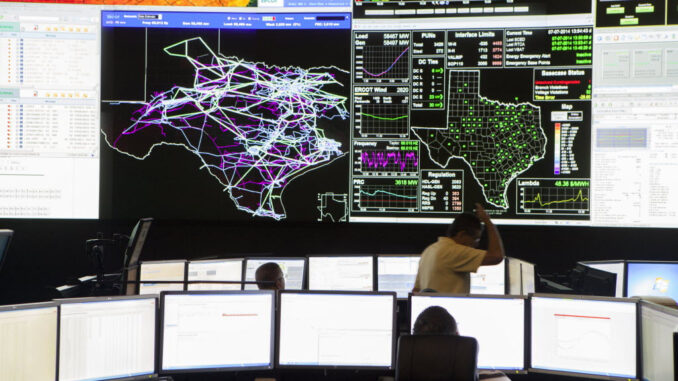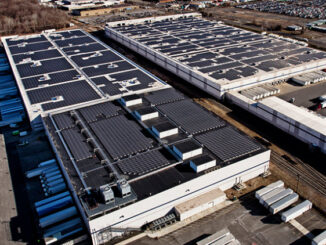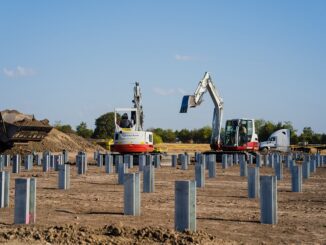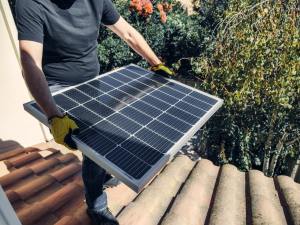
ENB Pub Note: Are we ready for 2022/23 winter? Look at Renewables and the Great Texas Blackout – Baker Institute Study stops short. Robert Bradly Jr. brings out some great points. A “Balanced Diet of Power” is required to run a grid. A balanced diet may include all forms of energy, but the availability to the grid Balancing Authorities (BA) is the most critical. The consumer’s price for kWh is higher the moment renewables are placed into a grid. We will cover why in future articles. Please let us know in the response form below what your thoughts are so we can evaluate and publish the facts available through all resources.
By Robert Bradley Jr.
“… communications between different regulatory agencies as the event approached were inadequate. Transparency regarding the location of natural gas supply infrastructure was atrocious.”
“Currently Texas is #1 in the nation in terms of existing wind capacity. It is also #1 in terms of planned capacity additions for wind and solar, and #2 in the nation for planned battery capacity additions. However, there is little-to-no planned capacity addition for other forms of dispatchable generation. This could become an issue for reliability.” (Baker Institute, study, below)
There is not only government failure in the quest to address market failure. There is analytic failure in identifying market failure that government is empowered to correct. Restated, problems attributed to markets are often the result of prior government intervention on close inspection.
This is true with some classic examples in the energy field, from the origins of public utility regulation of electricity to oil overproduction under the ‘rule of capture’, stories for another day.
Analytic failure has plagued a proper analysis of the Texas Blackout of February 2021, the greatest energy failure in U.S. history. Numerous studies dwelt on the physical seen of electricity provision during the winter storm (natural gas outages, in addition to wind/solar falloff).
But neglected–the rest of the story–is the unseen: renewable-energy–forcing over the last decade damaging the economics of the “reliables”–natural gas, coal, and nuclear. The result? Premature retirements, a lack of new capacity, and cost cut operations of dependable (baseload and dispatchable) generation. And other intervention contributed as well.
———————
Rice University’s Baker Institute recently released a study of the Texas debacle by economist Peter Hartley et al., ERCOT Froze in February 2021. What Happened? Why Did It Happen? Can It Happen Again? Political correctness rules at Rice and Baker, long a bastion of climate alarmism and forced energy transformation. So the study pulls its punches, requiring reading between the lines at times.
Still, compared to the usual fare, enough is said to get toward the real causality of wind/solar systemically damaging the grid–and a problematic future from increased wind/solar/battery reliance.
Where the study does not go is to a bottom-line verdict: a variety of reinforcing government intervention, state and federal, caused the unprecedented Texas Blackout of February 2021, a story I have outlined elsewhere. A “market failure” it was not!
The Baker study usefully presents a list of potential culprits in the mass blackout:
• wind generators,• thermal generators,• natural gas suppliers,• Texas opposition to inter-connections,• ERCOT management, and• ERCOT market rules.“Each of these could fairly share some blame, but none was solely responsible.”
Comment: Four of the six “scapegoats” involve government intervention: wind generators, Texas opposition to inter-connections, ERCOT management, and ERCOT market rules. (Nighttime and diminished daytime solar falloffs could be added–making a fifth government failure.)
But the other two reasons—thermal generators and natural gas suppliers—subtly involve government intervention. Specifically, the margins for the “reliables” have been compromised by a decade or more of artificially low margins from government-enabled wind and (on-grid) solar. Phantom (missing) generation and poor operating standards resulted. [1]
A total of 263 power plants within ERCOT experienced at least partial outages at some point between February 10 and 21, with 95 plants, accounting for 14.6 GW, experiencing a 100% shutdown. The peak capacity unavailability was over 40 GW on February 15-16. Natural gas and wind each accounted for about 41% of the peak unavailable capacity, while coal, solar and nuclear accounted for the remaining 14%, 3% and 2%, respectively. Excluding existing outages, ERCOT listed weather (53%), equipment issues (14%) and fuel limitations (12%) as the top three causes of the derated capacity. (pp. 9-10)
Comment: Call it a large cluster of entrepreneurial error. But profit-seeking entrepreneurship is all about anticipating and profiting from change and challenge. Why the failure?
All types of generation were compromised. For wind and solar, 139 and 23 units, respectively, experienced outages or derates during the freeze. Eight coal-fired power plants experienced derates or outages, losing a total of 5.6 GW. The partial outage at the South Texas nuclear power plant was causedby low steam generator levels from the loss of two feedwater pumps. One hydro plant and 9 battery storage facilities also experienced derates, although the lost capacity from these plants was minimal relative to the magnitude of overall outages. (p. 10)
Comment: Ditto–why the entrepreneurial failure with the ‘reliables’ when the greatest profits were available?
According to the Capacity, Demand and Reserves (CDR) report forERCOT published December 16, 2020, solar resources are rated at 80% of nameplate capacity during the summer, but only 7% during the winter. Wind resources in the Texas panhandle, the coast and other locations are rated at 29%, 61% and 19%, respectively, during the summer, and 32%, 43% and 19%, respectively, during the winter. The seasonal deratings, applied to assess “likely” resource availability, are based on the typical solar irradiance and wind velocities in each season and location. (pp. 10-11)
Comment: This is the intermittency problem that government policy put on an otherwise stable grid.
Natural gas capacity suffered the most outages and derates during the freeze, yet generated significantly more power than is typically seen during February…. The pattern prior to February 8 and after February 19 typifies February in ERCOT. Despite the outages …, roughly twice as much gas was used to generate electricity during the days running up to and during the winter freeze. Unfortunately, the grid needed more. This highlights the importance of “resilience” in energy systems, or the ability to respond when needed at all times and under all circumstances. (p. 11)
Comment: Imagine a free market, the difference being what was under government compared to what could and should have been in a free market.
In addition to load shed, the shortfall of generation relative to demand for an extended period drove extremely high payments to demand-side management program participants, which became politically contentious. These programs generally work as intended without issue. Their performance during the extreme winter storm is not evidence that they should be abolished. (p. 12)
Comment: Demand-side management, a regulatory program under public utility regulation, should not be excused or “grandfathered in” by political correctness. It should be abolished as part of a wider deregulation program.
The rapid pace of natural gas outages in the 12 hours following the EEA level 3 declaration is striking…. [L]oad shed orders in those 12 hours reached over 16 GWs. A confounding factor is that the coldest hours of the winter storm were also reached in morning hours of February 15, as was the peak anticipated demand. Unfortunately, absent data on the reason for outages at each generation facility hinders a deeper investigation of the natural gas-electricity interdependency. A University of Texas study commissioned by the PUC of Texas was given access to confidential data and noted,
“Wind turbines suffered some of the earliest outages and derates as freezing precipitation and fog resulted in ice accumulation on blades and – eventually, as temperatures dropped further – in the gearboxes and nacelles. Unit-specific data indicate that other types of generators – mostly those fueled with natural gas – were facing pre-blackout fuel supply issues, and were starting to go offline or derate capacity as early as February 10 due to fuel delivery curtailments.” (pp. 14-15)
Comment: This speaks for itself.
For the winter event of February 2021, communications between ERCOT and LDCs appeared satisfactory. However, communications between different regulatory agencies as the event approached were inadequate. Transparency regarding the location of natural gas supply infrastructure was atrocious. This has since been addressed by calls for a standing committee of personnel from various agencies. An alternative would be the creation of a single “Texas Energy Agency” with direct oversight of all relevant agencies. (p. 19)
Comment: Welcome to central planning–and the pressure to expand government intervention in the quest to correct prior government involvement. Here, the study should have at least footnoted the true free market alternative: remove state and federal regulation and allow “the obligation to serve” to go from regulators to companies.
From 2011–2021, responsive reserve capacity increased from 1062 MWs to 1570 MWs, that is, from 2.4% to 2.6% of forecasted peak load. The events of February 2021 suggest that this needs to be increased, and its operational capability warranted. According to ERCOT’s capacity, demand and reserves reports, the winter reserve margin was 72% of expected load in the winter of 2011, but had fallen to 43.2% for the winter of 2021. Some have called for adding a capacity market in ERCOT to improve reliability. However, a brief examination of historical electric disturbance events across the entire United States does not reveal that capacity markets are positively correlated to reliability. We suggest that this should be carefully examined before dramatically changing market structure in ERCOT. (pp. 19-20)
Comment: Hint, hint: renewables increased at the expense of forgone reliable capacity. How should it be addressed? A regulatory capacity market or not? How about neither–and private entrepreneurship pricing instead? Remember two-part pricing, a demand charge and a volumetric charge?
Even though deficient fuel supply was not a major cause of outages in the 2011 winter event, subsequent reports noted interdependence of electricity and natural gas markets in Texas and the importance of protecting natural gas production from cold-weather related disruption. Natural gas production and use in Texas have increased in the interim, as has the use of electric drive for compression (driven largely by environmental and operational motives). The latter has more deeply integrated electricity and natural gas markets. Moreover, gas has become more critical for balancing the electricity market as wind penetration has increased and coal use declined. There is no question that the natural gas production, gathering, storage and distribution facilities should be identified as critical load customers. (p. 20)
Comment: An unintended consequence of “green” government intervention: “… the use of electric drive for compression (driven largely by environmental and operational motives).”
Renewable generation has also been blamed for compromising reliability during the winter storm. The majority of wind generation capacity derating occurred prior to February 15, as equipment froze and generators were declared inoperable. This played a role in the subsequent cascading failures of natural gas generation by compromising electricity supply to field operations and supply infrastructure, but the story is hardly so simple because many other factors also contributed. In fact, during other periods when wind generation drops, which is a normal occurrence, fuel supply remains robust as other resources fill the power generation void. (pp. 21-22)
Comment: So intermittency played a part in neutering natural gas that, in turn, was not available for power generation. A second-order distortion from government intervention.
Historically, a diversity of resources was used to provide lowest cost dispatchable generation to serve loads at different times of the day. Over the last decade plus, wind generation capacity has grown substantially in ERCOT, and the variation in wind output has increased along with it. Although wind generation has desirable environmental attributes with regard to emissions, it is nondispatchable, and its output varies across short time intervals in unexpected ways. This places greater demands on dispatchable generation resources to be sufficiently responsive to maintain system balance. In ERCOT, natural gas generation has served this role. Moreover, the periods of highest grid stress historically occur during summer peak demand periods, where a combination of dispatchable resources – mostly natural gas – and demand-side management accommodate fluctuations in wind generation. (p. 22)
Comment: This also speaks for itself. “Although wind generation has desirable environmental attributes with regard to emissions…” is hardly a benefit compared to wounding a grid. (This sop to wind is political correctness.)
The consistent delivery of reliable electric power is the most sophisticated engineering and logistics problem in energy. Not only does demand vary within and across days, the availability of generation resources varies as well. Hence, there needs to be sufficient generation capacity that is capable of responding in real time to these fluctuations to maintain system balance. Reliability matters, and coordination across energy sectors, as well as across generation technologies, is essential. (p. 22)
Comment: Sounds like a challenge for free markets, not government officials. A footnote about the “knowledge problem” of central planning would have been appropriate here.
The diversity of available resources to meet unexpected changes in net load is important. Especially in the lead up to February 15, 2021, wind generation dropped and demand was high. If resources on the ERCOT grid had responded in February 2021 as they did in August 2020, market balance may have been possible without involuntary load shed. However, that possibility could not be realized due to a lack of adequate winter weather preparations and fuel supply deficiencies resulting from lack of coordination between the electricity and natural gas systems. (p. 25)
Comment: A “lack of coordination between the electricity and natural gas systems”? Coordination is a hallmark of market reliance. BTW, where are the combined gas and power companies to internalize transaction costs? Integrated power majors? Oh, they are not permitted under a 1935 federal law.
The debate around wind generation and its role in the winter storm outages thus has highlighted a critical issue in power systems with increasing penetration of non-dispatchable resources. When wind delivers above its seasonal rating, as it often does, price is driven down as wind displaces plants with higher operating costs. In the extreme, if wind is providing marginal output, price can be driven to minus the value of wind production subsidies (including renewable production credits). Wind generators are willing to pay up to that much to avoid simply spilling their output. When wind delivers below its seasonal rating, as it often does, price may not increase very much, depending on demand relative to available resources, due to the competition between generators at the margin. Thus, the net impact of variability in wind generation, ceteris paribus, can be to reduce incentive to invest in all types of capacity on the grid, which can compromise reliability over time. In effect, the social benefit of reliability associated with available, dispatchable generation capacity, regardless of type, is left unaccounted if it is not fully priced into a market where load net of non-dispatchable generation becomes increasingly variable. Questions of market design, and the pricing of reliability, as the proportion of non-dispatchable capacity on the grid increases are fundamental to the future of grid design, but a full exploration is beyond the scope of this paper. (p. 24)
Comment: BINGO! This is where an econometric study needs to be done to estimate how higher margins, sans wind and solar, would have resulted in greater reliable capacity and better maintained capacity.
Wind underperformed relative to its nameplate capacity, but this is always true. While the narrative around the incredible growth of wind is usually framed around installed nameplate capacity, expectations for wind generation should not be based on nameplate capacity because that amount of energy is rarely, if ever, delivered on a day-to-day basis. The more relevant benchmark for expected performance is rated capacity. Wind generation capacity is “rated” at a discount to nameplate capacitythat is inherently based on the expected availability of wind resources from day-to-day, which is why wind is referred to as a “non-dispatchable” resource. Wind often outperforms expectations, or exceeds its capacity rating, but it also often underperforms relative to its capacity rating. During the winter storm, wind underperformed on that metric. (pp. 24-25)
Comment: Wind power is a mess in a world where reliability is the most important factor given the instantaneous nature of electricity production and consumption. The Texas grid needs less, not more, wind power (and solar power).
All this stated, the reason for wind’s underperformance during the winter storm, as opposed to other times of year, was only important for grid stability because other resources were also not available. It is well known by grid operators and power market participants that wind varies frequently, so planning should ensure the availability of other flexible resources that can respond quickly and reliably to maintain supply when wind is unavailable. As the fraction of supply coming from non-dispatchable resources increases, the social value of reliability, the value of lost load and demand flexibility become more important issues that must be addressed and internalized by market participants, regulators and ultimately consumers. A resilient, reliable electricity system requires resources to be appropriately priced to ensure adequate levels of investment in all types of capacity. None of this means that we should notinvest in wind. It does raise questions, however, about what drives investment in various forms of generation capacity (i.e.- subsidies, mandates, commercial returns, environmental preference, etc.) and whether capital is being appropriately directed, but that is beyond the scope of this paper (p. 25)
Comment: Perhaps it does suggest that “we” not invest in wind power, a notorious drain and parasite on the reliables. Wind and solar are politically correct, economically incorrect resources.
Thermal capacity suffered significant deratings, but the reasons varied across generation types. A facility-by-facility assessment is needed to ensure similar types of outages do not recur. A lack of transparency on all facility-specific derates means that regulators must address this issue with facility owners. As noted above with regard to wind capacity, winterization of thermal capacity can be an important first step. If all capacity in ERCOT had remained operable during the winter storm, load shed would have likely been necessary, but remained voluntary, thereby avoiding the EEA level 3 declarations. Nevertheless, the value of winterization may vary in different parts of the state and across generators, so a careful analysis of reliability standards that accounts for location and age is needed to drive a better long-run outcome. (p. 25)
Comment: Winterization? Why does this have to be mandated? Private companies have incentives to operate during high-margin periods and are subject to must-perform contracts in a real free market. Higher margins from less intermittent sources is a better approach.
During the February 2021 winter freeze, natural gas generated more power than any other source, and natural gas generation exceeded what it would have been on an average February day. But the winter storm of February 2021 was not average; it was extreme. Power cuts to infrastructure along the natural gas supply chain played a major role in the failure of natural gas generators. Hence, to avoid a single point of failure along the circular, interdependent natural gas-electricity value chain, fuel supply chain infrastructures should be mandatorily designated as critical load customers. (p. 25)
Comment: Electricity failed natural gas, not only did natural gas fail electricity. Intermittent resources again.
ERCOT’s resource adequacy assessments need to be further enhanced to better account for extreme winter events…. As such, better coordination among state agencies is needed. Perhaps a single “Texas Energy Agency” could have ensured better coordination by establishing greater accountability and transparency through agency derived protocols across various offices. Regardless of the approach taken, better coordination and information sharing is needed. The effectiveness of steps taken to date, such as establishing a standing committee comprised of representatives from different state agencies, remains to be seen. (p. 26)
Immediate calls for a capacity market in the wake of the winter freeze ignore the fact that neither nameplate nor rated capacity adequacy was the issue. Operational capacity adequacy, or ensuring existing capacity is operational, was the problem. Even if a capacity market had ensured more capacity were on the ERCOT grid, the other problems we identified suggest that capacity would have likely been inoperable too. Winterizing existing generation and energy infrastructure along with correcting fuel supply issues would have abated the crisis that unfolded. Nevertheless, a careful analysis of reserve margins as intermittent capacity expands is warranted. (p. 26)
Comment: Master of the obvious, plus pulled punches.
… a careful analysis of reserve margins as intermittent capacity expands is warranted. Currently Texas is #1 in the nation in terms of existing wind capacity. It is also #1 in terms of planned capacity additions for wind and solar, and #2 in the nation for planned battery capacity additions. However, there is little-to-no planned capacity addition for other forms of dispatchable generation. This could become an issue for reliability. For example, wind generation in Texas is at seasonal maximum in the fall, while demand is a maximum in the summer. Battery installations currently planned are short duration and will convey significant benefits for frequency management. However, during events such as the winter freeze of February 2021, or even more regular occurrences of meeting peak summer demands when the wind is not available, other types of backup capacity are needed. If the load growth in ERCOT over the last 20 years continues, as is projected, resource inadequacy could become a more frequent issue. Hence, factors such as the social value of reliability, the value of lost load and increased demand management need to be more actively discussed and integrated in market rule-makings so that they can be appropriately priced to ensure adequate levels of different types of investment. (p. 26)
Comment: Ditto: master of the obvious and pulled punches. A true free market in electricity, anyone?
———–
[1] A proper study of the Great Blackout would calculate the reduction in margins had a free market been in place versus what resulted from wind/solar forcing. This difference would then be translated into (reliable) capacity and improved operating performance. Estimates of the unintended effects of other government involvement versus a true free market would be necessary too.



